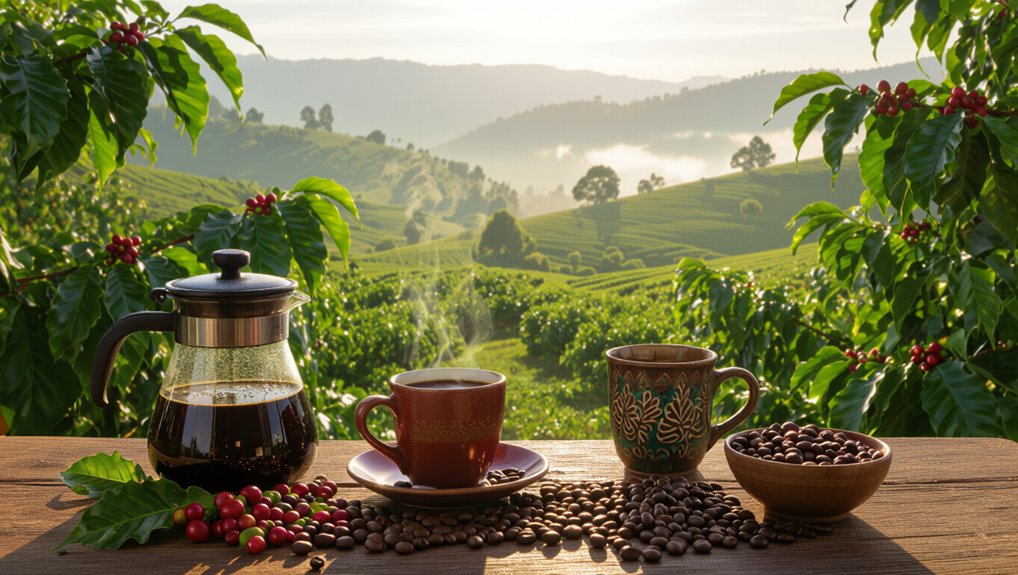Ever wondered where your daily cup of coffee actually comes from? Most coffee drinkers know their favorite brands and local roasters, but few realize which countries are truly powering the global coffee industry. The world’s biggest coffee producers shape everything from the flavors in your mug to the prices you pay at your local café.
This post will reveal the top coffee-producing nations that dominate the global market and explore what makes each country’s contribution unique. You’ll discover which unexpected countries have climbed the ranks, how different regions affect coffee quality and taste, and why understanding these major producers matters for every coffee enthusiast.
Whether you’re curious about your coffee’s origins or want to make more informed choices about the beans you buy, knowing the world’s coffee production leaders will give you a deeper appreciation for that perfect morning brew.
Table of Contents
Brazil: The Coffee Production Powerhouse
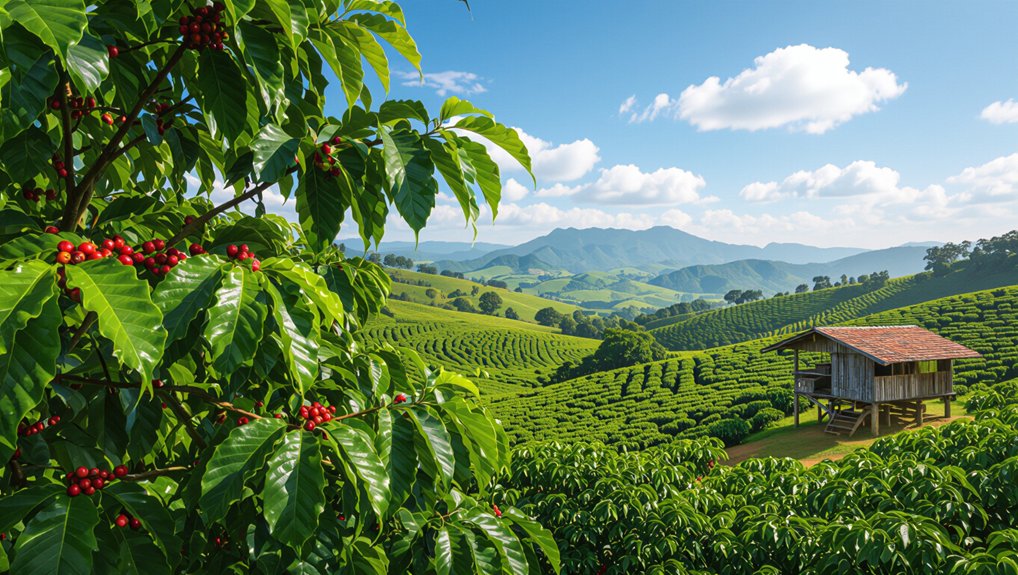
When it comes to coffee production, Brazil stands unrivaled as the global powerhouse, consistently dominating the industry for well over a century.
With an annual output of 2.68 million metric tons, Brazil leads global coffee production, cultivating both Arabica and Robusta beans across regions like Minas Gerais.
The country’s rich, fertile soil and ideal climate conditions contribute to its exceptional coffee quality.
You’ll love the signature Brazilian coffee profile—a creamy body with low acidity and delightful hints of chocolate and caramel.
This remarkable legacy secures Brazil’s position as the world’s largest coffee producer.
Vietnam’s Robusta Revolution
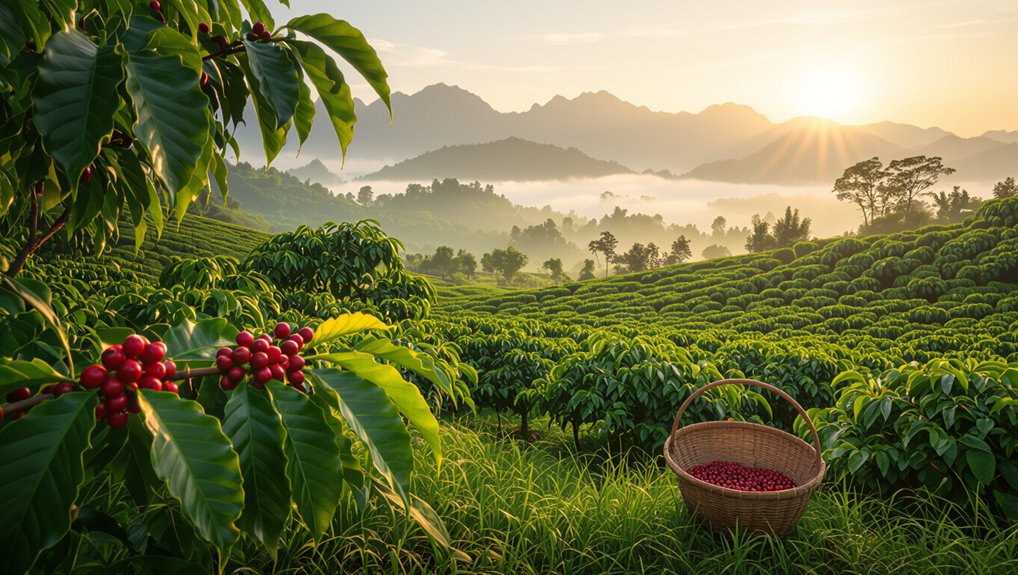
Vietnam’s coffee journey is a remarkable tale of transformation from a French colonial curiosity to a global Robusta powerhouse. By leveraging the Central Highlands’ perfect growing conditions, the country rocketed to become the second-largest coffee producer worldwide.
| Statistic | Value | Significance |
|---|---|---|
| Global Rank | #2 | Coffee Production |
| Annual Output | 1.5M Metric Tons | Robusta Dominance |
| Export Focus | Instant Coffee | Low Acidity Beans |
Economic reforms in 1986 catalyzed this coffee revolution. With over 95% of production dedicated to Robusta beans, Vietnam crafted a unique coffee identity characterized by low acidity and robust flavor—perfect for instant coffee markets globally.
Colombia’s Arabica Excellence
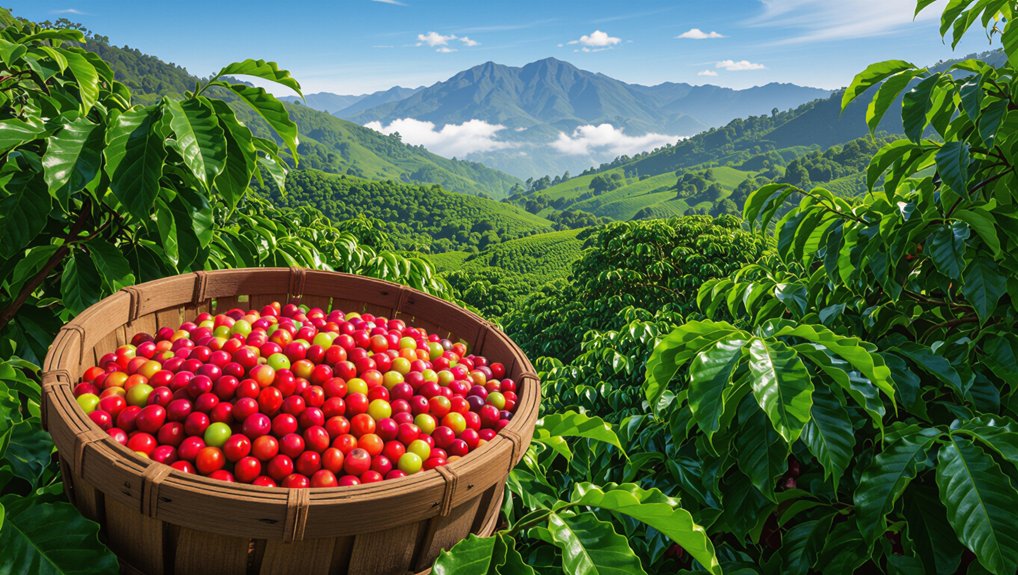
Because Colombia’s coffee landscape is as diverse and vibrant as its culture, coffee enthusiasts will find an extraordinary narrative of agricultural excellence and passion.
My expertise reveals Colombia’s commitment to high-quality Arabica beans, cultivated in mountainous regions like Antioquia and Caldas. The country’s smooth flavor profile stems from meticulous washed processing during harvest seasons from September to January.
These practices support the economy and empower smallholder farmers, making Colombian coffee a global benchmark. With annual production exceeding 754,376 metric tons, Colombia isn’t just producing coffee—it’s crafting liquid art that delights palates worldwide.
Indonesia’s Unique Coffee Landscape
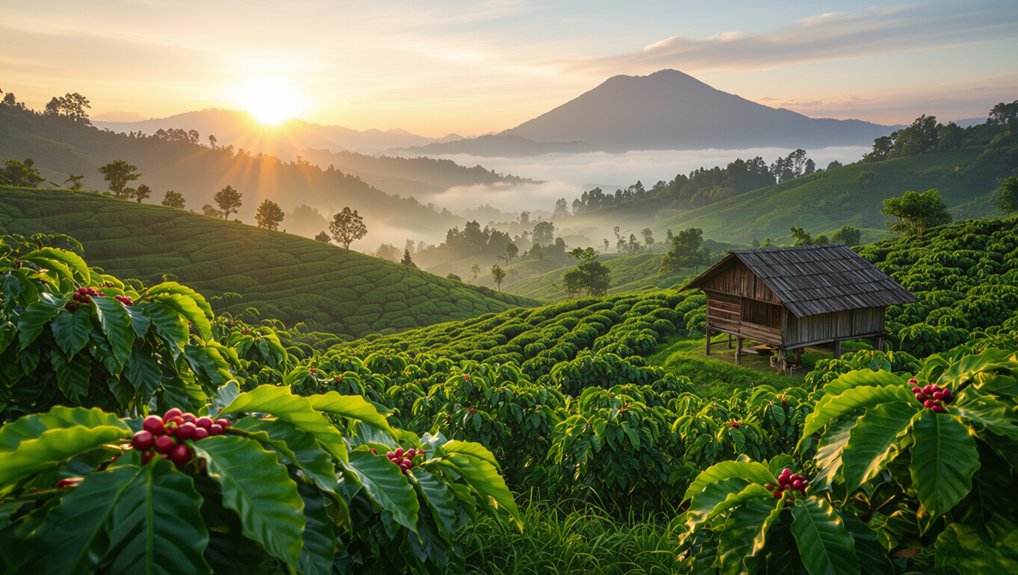
From the vibrant coffee fields of Colombia, we now journey to the lush, volcanic landscapes of Indonesia—a nation that’s revolutionized global coffee production.
Indonesia stands out with its remarkable 668 thousand metric tons of annual coffee output, dominated by Robusta (60%) and distinctive Arabica beans.
The country’s unique “giling basah” processing method transforms coffee, creating earthy, complex flavor profiles that tantalize coffee lovers worldwide.
Regions like Sumatra, Java, and Sulawesi contribute their volcanic soil’s magic, nurturing specialty coffee that supports local economies and delights international palates with its extraordinary character.
Honduras: Small but Mighty Coffee Producer
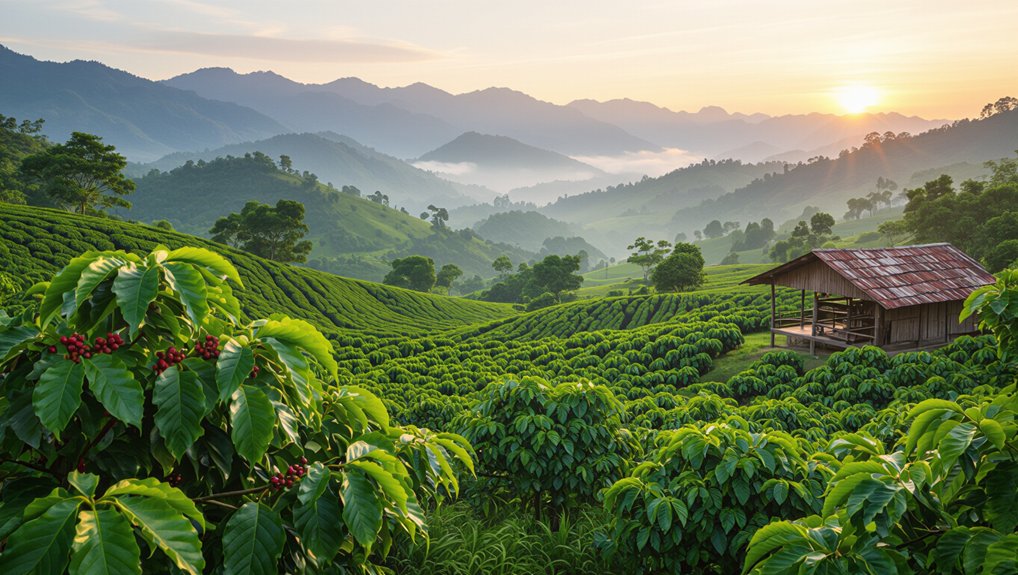
While many coffee enthusiasts might overlook Honduras, this Central American gem has quietly become a powerhouse in the global coffee scene.
I’ve discovered that Honduras ranks fifth worldwide in coffee production, specializing in exceptional Arabica beans grown on family-owned Fincas. These smallholder farmers cultivate remarkable coffee in regions like Santa Bárbara and Copán, where high altitudes craft extraordinary flavor profiles.
From October to March during the harvest season, carefully handpicked cherries transform into sought-after beans that are increasingly prized in specialty coffee markets.
Honduras proves that size doesn’t determine coffee quality.
Ethiopia: The Birthplace of Coffee
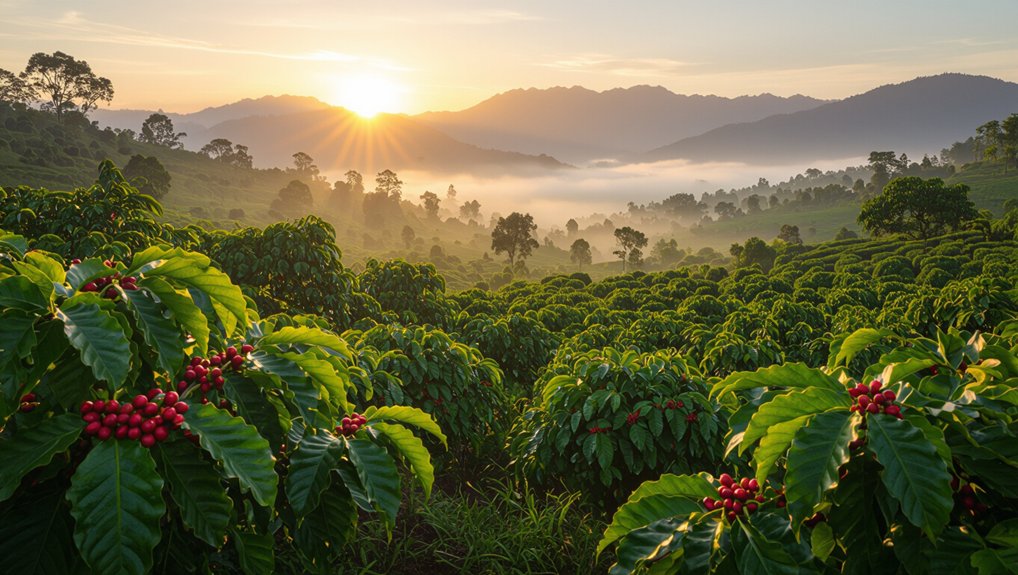
Legends whisper through Ethiopian highlands, telling tales of coffee’s miraculous discovery centuries ago.
As the birthplace of Coffea arabica, Ethiopia isn’t just a coffee producer—it’s the spiritual home of your morning brew. You’ll find diverse bean varieties like Sidamo and Yirgacheffe that represent 8.6% of global coffee production.
Coffee cultivation here isn’t just agriculture; it’s a cultural heartbeat connecting millions of smallholder farmers. With coffee contributing roughly 10% to Ethiopia’s economy, each cup tells a story of tradition, community, and extraordinary flavor that transforms a simple beverage into a profound cultural experience.
Peru’s Emerging Coffee Scene
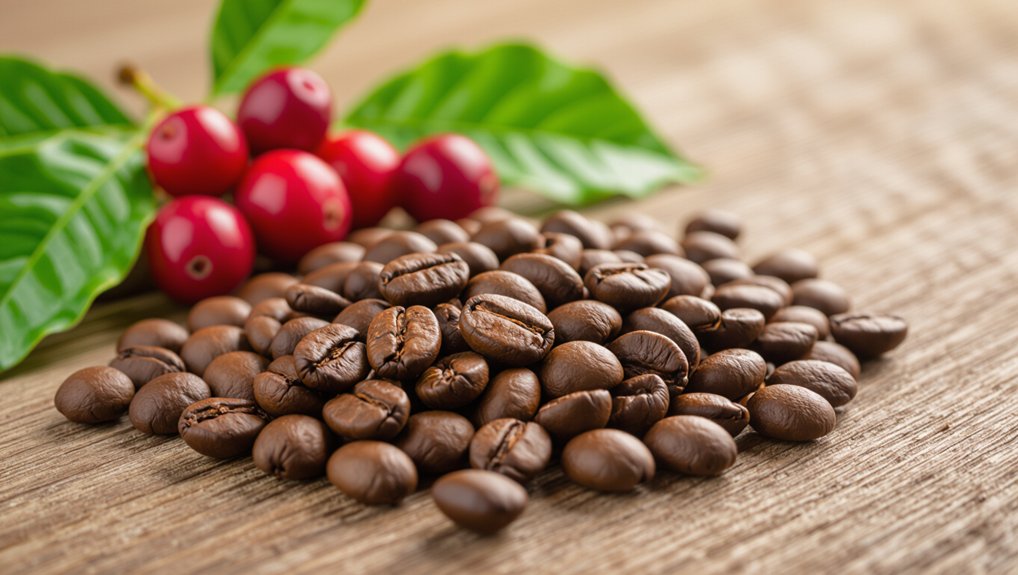
Just as Ethiopia’s rich coffee heritage set the stage for global coffee culture, Peru’s emerging coffee scene is quietly revolutionizing the specialty coffee landscape. With its Fair Trade and organic Arabica coffee, Peru contributes 2.4% to global production through diverse microclimates and sustainable practices.
| Region | Key Varietal | Harvest Period |
|---|---|---|
| Junín | Typica | May-June |
| Cajamarca | Bourbon | June-July |
| San Martín | Caturra | July-August |
| Amazonas | Catimor | August-September |
Peru’s coffee farmers are crafting exceptional flavor profiles through meticulous washed and honey processing techniques, making this South American nation a rising star in specialty coffee production.
India’s Southern Coffee Regions
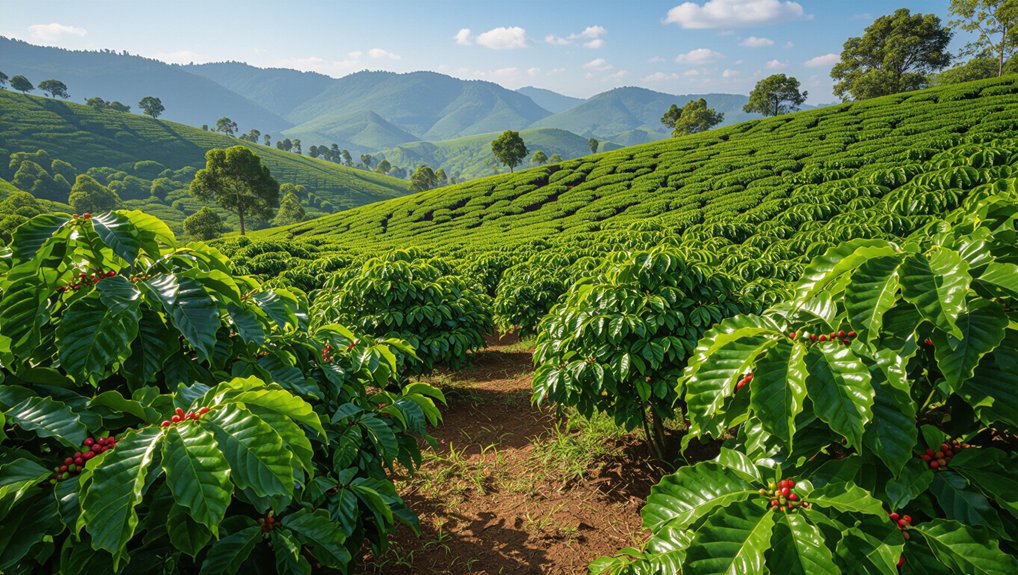
Because coffee cultivation in India represents a fascinating blend of tradition and innovation, southern regions like Karnataka, Tamil Nadu, and Kerala have emerged as powerhouses in the global coffee landscape.
Karnataka leads the charge, producing a whopping 70% of India’s coffee, with Arabica and Robusta varietals thriving in these lush landscapes.
The harvest season from November to February brings hand-picked beans that create unique offerings like Monsoon Malabar—a distinctive coffee processed under monsoon conditions.
With an annual production of 234,000 metric tons, India’s coffee scene continues to captivate coffee enthusiasts worldwide.
Guatemala’s Coffee Heritage
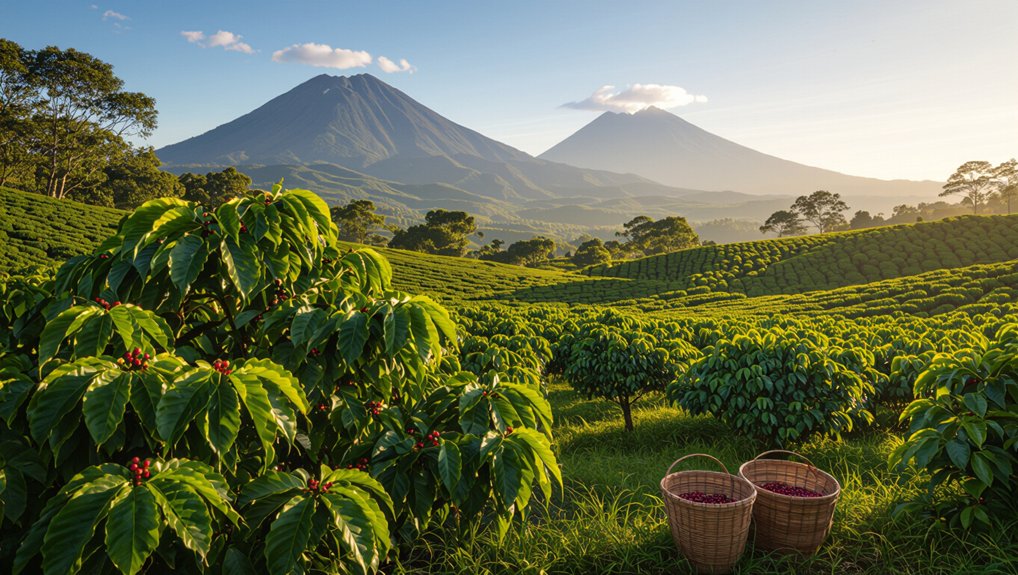
When you explore Guatemala’s coffee landscape, you’ll discover a rich heritage that transforms every sip into a journey through volcanic landscapes and generations of agricultural expertise. This high-quality Arabica coffee powerhouse produces 3.42 million bags annually, showcasing distinctive taste profiles from regions like Antigua and Huehuetenango.
| Region | Altitude | Key Varietal |
|---|---|---|
| Antigua | 1,500m | Bourbon |
| Atitlán | 1,700m | Caturra |
| Cobán | 1,300m | Catuai |
| Huehuetenango | 2,000m | Pacamara |
| Acatenango | 1,600m | Typica |
Sustainability defines Guatemala’s traditional farming practices, with shade-grown and organic methods preserving biodiversity during the November-March harvest season.
Uganda’s Growing Coffee Industry
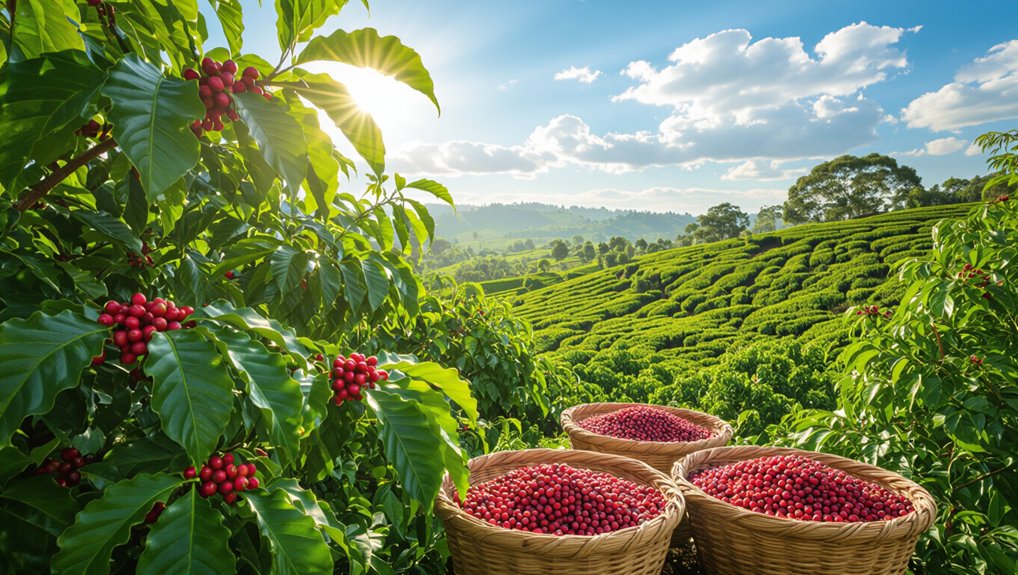
Although often overshadowed by more famous coffee-producing nations, Uganda has quietly emerged as a powerhouse in the global coffee landscape.
This East African gem boasts impressive coffee credentials that’ll intrigue any coffee enthusiast. Dive into Uganda’s coffee world:
- Ranks tenth globally in coffee production
- Dominates Robusta coffee with over 209 thousand metric tons annually
- Features unique wine-like Robusta with rich chocolate notes
- Supports numerous farmers through coffee cultivation
Uganda’s diverse coffee-growing regions—from western Nile to Bugisu—produce exceptional specialty Arabica and Robusta beans, contributing significantly to national export revenues and local livelihoods.
Frequently Asked Questions
Who Is the Top 5 Coffee Producer in the World?
I’ll tell you the top 5 coffee producers: Brazil leads the pack, followed by Vietnam, Colombia, Indonesia, and Honduras. These countries dominate global coffee production, with Brazil contributing nearly a third of the world’s coffee.
Who Is the Largest Coffee Manufacturer in the World?
I can confidently say that Brazil is the largest coffee manufacturer globally, producing approximately 2.68 million metric tons annually and accounting for about 30.8% of worldwide coffee production for over 150 years.
Who Is the World Leader in Coffee Production?
I’ll tell you straight: Brazil is the world leader in coffee production. We’ve consistently topped global charts, producing nearly 31% of the world’s coffee and maintaining this impressive status for over 150 years.
What Is the Top 5 Coffee in the World?
I’ll help you rank the top 5 coffee-producing countries! Brazil leads with 30.8% of global production, followed by Vietnam, Colombia, Indonesia, and Ethiopia, each offering unique coffee varieties and contributing significantly to the world’s coffee supply.
In Conclusion
Coffee’s global landscape is a rich tapestry of flavors and traditions. You’ll discover that each country brings something unique to your morning brew, from Brazil’s massive production to Colombia’s prized Arabica beans. These top producers aren’t just numbers—they’re storytellers, sharing their cultural heritage through every carefully cultivated coffee bean. Whether you’re a casual sipper or a passionate enthusiast, grasping these origins deepens your appreciation for that perfect cup.

